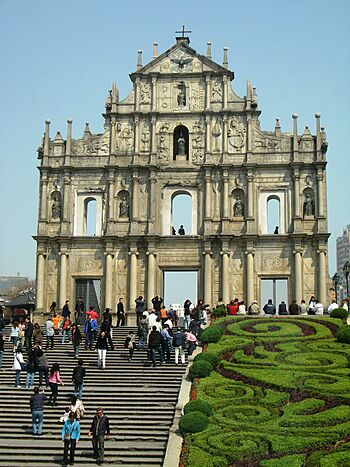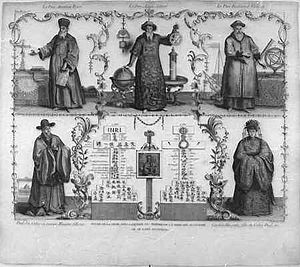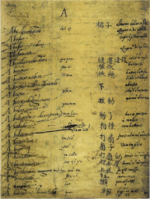St. Paul's College, Macau facts for kids

Ruins of St. Paul's, showing the remaining facade of the Madre de Deus church
|
|
|
Former names
|
Madre de Deus School |
|---|---|
| Type | Private Roman Catholic research non-profit all-male Higher education institution |
| Active | 1594–1762 |
| Founder | Fr. Alessandro Valignano, SJ |
|
Religious affiliation
|
Roman Catholic (Jesuit) |
| Location |
Santo António
,
Macau
,
China
|
| St. Paul's College, Macau | |||||||
|---|---|---|---|---|---|---|---|
| Chinese name | |||||||
| Traditional Chinese | 聖保祿學院 | ||||||
| Simplified Chinese | 圣保禄学院 | ||||||
|
|||||||
| Portuguese name | |||||||
| Portuguese | Colégio de São Paulo | ||||||
St. Paul's College of Macau (Portuguese: Colégio de São Paulo; Chinese: 聖保祿學院), also known as College of Madre de Deus, was a famous school founded in 1594 in Macau. It was started by a group of Catholic priests called Jesuits, who worked with the Portuguese government. Many people consider it the first Western-style university in East Asia.
St. Paul's College was created by Alessandro Valignano in 1594. It grew from an earlier school called Madre de Deus. The college helped prepare Jesuit missionaries who were traveling to countries in the East. Students learned important subjects like mathematics, geography, astronomy, and different languages such as Latin, Portuguese, and Chinese. It also had a school for music and arts.
This college was very important for learning about Eastern languages and cultures. It was home to some of the first Western scholars who studied China, known as sinologists. Famous scholars like Matteo Ricci, Johann Adam Schall von Bell, and Ferdinand Verbiest studied or taught there.
The college was a main base for Jesuit missionaries going to China, Japan, and other parts of East Asia. It was also connected to a busy trade route between Macau and Nagasaki until 1645. After a big rebellion in Japan, which was partly blamed on religious influence, Japan sent the Portuguese away and banned Catholicism. The college then became a safe place for Christian priests who were escaping.
Some of the college's teaching moved to the Seminário de São Jose in 1728. Today, the University of Saint Joseph continues this tradition of learning, especially in religious studies and philosophy. The Jesuits left the college in 1762 when the Portuguese government expelled them. The buildings were later destroyed in a fire in 1835. In 2005, the ruins of St. Paul's—especially the front wall of the Madre de Deus Church—became a UNESCO World Heritage Site.
The College's Beginnings

Bottom: Paul Siu, a high-ranking government official; Candide Hiu, granddaughter of Paul Siu.
Since 1557, Portuguese Macau was the main place for trade between China and Japan. From there, goods traveled to Europe through Goa. In 1571, Nagasaki opened its port to Portuguese ships after an agreement with a local leader named Ōmura Sumitada, who became Catholic. This led to a thriving trade between Macau and Nagasaki, known as the "Nanban trade period".
Christian missionary work in Japan started in 1549 when a Jesuit leader named Francis Xavier was welcomed and allowed to preach. Jesuits set up churches in different Japanese cities. By 1579, there were about 130,000 Christian converts. Many local leaders, called daimyōs, became Christian, sometimes to gain access to trade and weapons.
Francis Xavier tried to reach China in 1552 to speak with the Chinese Emperor. He wanted to help Portuguese people who were held prisoner in Guangzhou. However, he died off the coast of China, on Shangchuan Island. Even though Macau was given to the Portuguese, contact with mainland China was always difficult.
In 1576, Pope Gregory XIII included Japan in the Portuguese diocese of Macau. In September 1578, Alessandro Valignano arrived in Macau. He was sent to check on and reorganize the Jesuit missions in the Indies. While missions in Japan were growing, none had succeeded in mainland China. Valignano believed that learning the Chinese language was key. He asked for help, and Jesuit scholar Michele Ruggieri came to Macau. Matteo Ricci joined him in 1582. Together, they became the first European scholars to deeply study China and its language.
Valignano visited Japan for the first time in 1579. Before he arrived, missionaries complained that there was no language training. Francis Xavier had simply read a Japanese translation of a religious book. Valignano made it a rule that all new missionaries in Japan had to spend two years learning the language. This greatly improved their ability to communicate.
In 1580, a Japanese leader gave control of Nagasaki to the Jesuits. Later that year, the armies of Philip II of Spain won a battle and claimed the throne of Portugal. This united the Spanish and Portuguese empires, which worried people in Macau and Nagasaki. It threatened China's permission for the Portuguese to stay in Macau and challenged their trade monopoly.
In 1583, the Portuguese in Macau were allowed to form a local government and kept their independence. Macau became very successful, and Jesuits also got involved in trade. This trading by religious groups was unusual and noticed by others. Eventually, the Pope had to step in and ordered the Jesuits to stop all trading activities in 1585. Valignano strongly appealed to the Pope, explaining that the Jesuits needed the money for their many projects.
In 1594, St. Paul's College of Macau was officially approved by the Jesuit leader in Rome. It grew from the earlier Madre de Deus school. At first, the college had two seminaries for religious brothers, a university with departments for arts, philosophy (the study of ideas), and theology (the study of religion). It also had a primary school and a school for music and arts. By 1595, Valignano proudly wrote that the Jesuits had printed a Japanese grammar book and dictionary in Nagasaki. They also printed several books, mostly about saints and martyrs, entirely in Japanese. The main parts of the grammar and dictionary were put together between 1590 and 1603. The dictionary alone had about 32,798 entries.
Between 1597 and 1762, the college greatly influenced Jesuit missionaries learning Eastern languages and cultures. Macau became a base for spreading Christianity in China and Japan. The college's academic program became very complete, similar to a university. It included important subjects like theology, philosophy, mathematics, geography, astronomy, Latin, Portuguese, and Chinese. Many famous scholars taught and learned at this college. It was home to the first Western scholars of China, like Matteo Ricci, Johann Adam Schall von Bell, and Ferdinand Verbiest.
Macau was therefore a training ground for missions in Asia. From 1597 until 1762, Jesuit priests going to China always came to Macau first. At St. Paul’s College, they learned Chinese and other areas of Chinese knowledge, including philosophy and different religions. This knowledge helped them in later discussions about allowing local Chinese customs in Christian practices. It was the largest seminary in East Asia at the time and the first Western-style university in the region.
Important Scholars
Many important people studied or taught at St. Paul's College. Here are some of them:
- Alessandro Valignano (1578) He founded the college in 1594 and encouraged the study of Japanese language and Chinese language.
- Michele Ruggieri (1579) He helped write the first ever Portuguese-Chinese dictionary.
- Matteo Ricci (1582) He also helped write the first ever Portuguese-Chinese dictionary.
- João Rodrigues (around 1574–77 and 1610–33) He organized the first ever European (Portuguese)-Japanese dictionary, called the Nippo Jisho.
- Johann Adam Schall von Bell (1619) He was an advisor to the Shunzhi Emperor and led the Imperial Observatory and the Tribunal of Mathematics.
- Alexander de Rhodes (1630–1640) He wrote the first Vietnamese-Portuguese-Latin dictionary, published in Rome in 1651.
- Michał Boym (1643) He was a teacher at the College and wrote many books about Asian animals, plants, and geography.
- Ferdinand Verbiest (1659) He was a mathematician and astronomer. He corrected the Chinese calendar and was the head of the Mathematical Board and Director of the Observatory.
- Thomas Pereira (around 1665–73) He is thought to have brought Western music to China. He was an envoy for the Kangxi Emperor and helped secure the Treaty of Nerchinsk.
- Wenceslas Pantaleon Kirwitzer
- Manuel Dias (Yang MaNuo)
- Martino Martini
- Giulio Alenio
- Xu Guangqi
- Wu Li
- Petro Kasui Kibe
See also
- Jesuit China missions
- Padroado
- Saint Paul's College, Goa
- List of Jesuit sites


